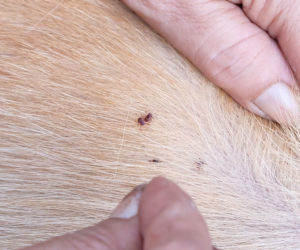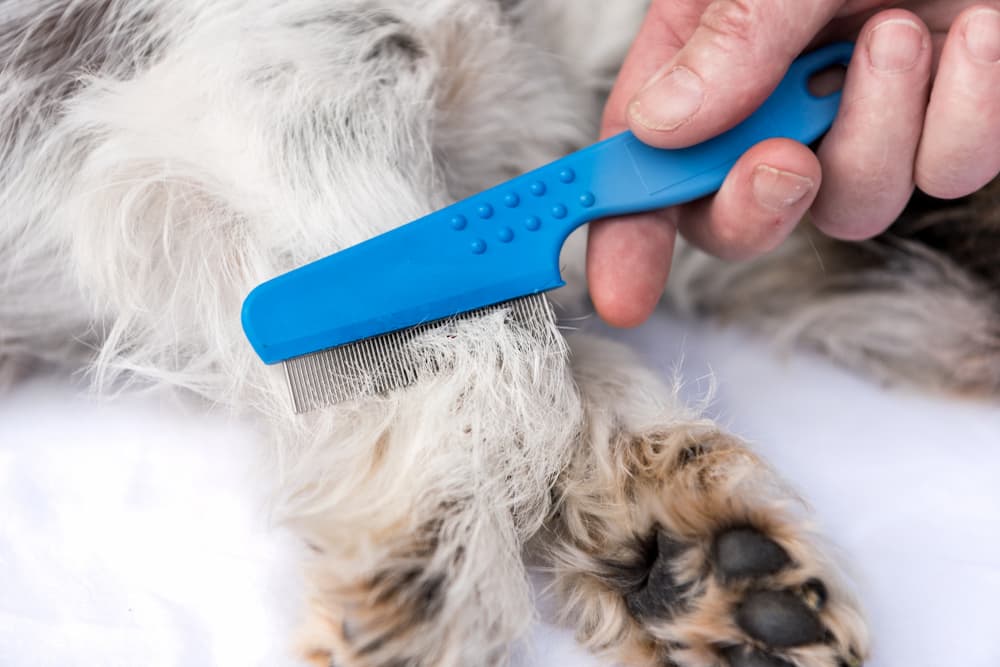A single
can cause pets to scratch excessively and become agitated. As well as itching, red pimples or bumps on your pet’s groin, belly, under the legs, or at the base of their tail may be a sign that your pet has fleas. Hair loss and dry skin due to scratching may also be a sign of fleas on your dog or cat.
Fleas are more than unsightly. If left unchecked, these blood-sucking parasites can damage skin and result in infections, causing significant discomfort for dogs. Dogs frequently have fleas, which are also a major factor in developing skin conditions.
Therefore, learning to spot fleas before they can cause damage is a useful skill, but spotting these tiny abominations is challenging. The symptoms these parasites produce are similar to those of illnesses not brought on by fleas, and they can move quickly and undetected.
We’ve put together a guide that demonstrates how to determine whether your dog has fleas, how to get rid of them once you do, and what you can do to avoid future occurrences in order to help take the guesswork out of flea identification. If you suspect your dog has fleas, you should always contact your veterinarian to discuss the situation.
How to Check Your Dog for Fleas
Make it a routine to inspect your dog’s comb or brush during routine grooming sessions to see if there are any signs of fleas. There are several ways to check your dog for fleas if you suspect a problem.

Have your dog’s veterinarian examine her if you can’t find any fleas, flea dirt, or flea eggs but she continues to scratch or appears uncomfortable. Your veterinarian can perform a skin test to check for flea allergies. Additionally, the vet can determine whether your dog has a different allergy during your visit, such as a food, atopic, or contact allergy.
How to tell if your dog has fleas
There are a few obvious symptoms that your dog is getting bitten if it has fleas. Heres what you should do to check for fleas:
1. Notice if your dog is scratching more often: One of the tell-tale signs that your dog has fleas isnt the flea itself, its your dog. If you notice your dog regularly scratching, biting, or chewing at their skin it could mean hes infected with fleas.
2. Take a close look at your dogs fur: Fleas are dark brown and very tiny, about 0.1 to 0.3 centimeters big, the size of a small crumb, but theyre still able to be seen with the naked eye, says Alison Meindl, DVM, DABVP, assistant professor at the Colorado State University Veterinary Teaching Hospital.
By separating the dog’s hair and looking for them on their skin, you can detect fleas. If something looks like a flea but you’re not sure, a good sign is that it moves around by jumping rather than crawling.
The purpose of flea combs, which have very closely spaced teeth, is to remove fleas from hair so you can more easily identify them. The hair at the base of your dog’s tail is the best place to look for fleas on an infested dog, advises Meindl.
3. Look for “flea dirt”: According to Gary Richter, DVM, a veterinary health expert with Rover, you can recognize fleas by the presence of “flea dirt.” He claims that what appears to be dark, granular material is actually digested blood. A small amount of water will cause the substance to turn red. This is another surefire way to identify fleas.
4. Check for bites: According to Richter, you might also want to keep an eye out for flea bites, which appear as tiny red bumps on your dog’s skin.
Identifying Fleas: The Basics

Once you can spot fleas on your dog, you’ll be in a better position to relieve their itching and discomfort and avoid health issues like bacterial infections and hot spots.

Finding fleas on dogs isn’t easy. In addition to being roughly the size of a sesame seed, these reddish-brown parasites have a flattened body that allows them to move quickly and remain undetected. Fleas are wingless insects, so even though they can’t fly, they have long hind legs that allow for high-level jumping. The rows of comb-like, spiny structures on their legs, back, and mouth enable them to keep a firm grip on dogs.
So how do you look for something so undetectable? It’s easier to look for flea excrement (flea dirt) than actual fleas, veterinarians say. You can accomplish this with a flea comb,” says Dr. Susan O’Bell, service director at Angell Animal Medical Center in Boston.
When combing the hair or fur, she remarks, “This looks like coffee grounds or dirt on the comb, especially down the back toward the base of the tail.”

Even more challenging to spot than adult fleas are flea eggs. They are oval, off-white in color, and roughly the size of a grain of salt. Despite being on the coat, they can be mistaken for dry skin, according to Dr George Melillo is the co-founder and chief veterinary officer of the Philadelphia-based company Heart + Paw.
You can get a better look by using a flea comb to gently pull the fur away from the skin, advises O’Bell, a board-certified veterinarian in internal medicine.
Flea eggs don’t remain on dogs for very long, though. The majority of flea eggs will fall off a dog soon after they are laid, according to O’Bell, and if they land on warm carpets, blankets, or bedding, they can easily hatch, leading to fleas returning to your dog.
According to O’Bell, flea bites on dogs appear as tiny, raised red dots. They are typically smaller than other insect bites, but once a dog scratches the itch, they can become easily inflamed and appear larger. ”.
The size of the bite can vary, however. According to O’Bell, “some dogs will experience a much stronger itch reaction than others, which frequently results in a much larger and more noticeable red area.”

In addition to confirming that your dog has fleas, flea dirt, or flea eggs, there are some additional symptoms you should look out for. If you notice anything unusual, we advise getting in touch with your veterinarian because these symptoms can appear in unrelated conditions.
One of the most typical symptoms of canine fleas is excessive scratching or biting at the fur, according to Melillo. “Dogs scratch on occasion just like people do. Fleas should be taken into account if the pet starts chewing or scratching at the fur in an unusual way. ”.
Strong itching is not always caused by a flea infestation, either. According to Melillo, “some dogs will be hypersensitive to fleas, and one or two fleas will cause intense itchy skin.”

The constant biting and scratching can harm your dog’s skin. The skin can quickly turn quite red, raw, and experience fur loss, especially in dogs who have flea allergies, according to Melillo.
A course of antibiotics and steroids may be recommended by your veterinarian if these hot spots, also known as acute moist dermatitis, become infected and swollen.
Dogs with flea bites will have tiny, red, raised spots on their skin, according to Melillo. They are tiny and frequently only visible in spots with thin fur, such as the belly or the base of the tail. In some dogs, flea bites can also swell up and look larger.

Flea dirt, which is different from flea eggs in that it contains the dog’s digested blood, is more frequently discovered on dogs than live fleas. “Flea dirt will appear reddish brown when placed on a wet paper towel,” says the speaker. It is a sign of fleas,” says Melillo.
One of the many indications that a dog has fleas is pale pink to white gums. Due to the fact that fleas feed on their hosts’ blood, a flea infestation can cause significant blood loss, which will manifest as pale gums. Healthy gums are salmon pink, shiny, and moist. If you notice pale gums and think your dog may have fleas, call a veterinarian right away or take them to an emergency clinic right away.
Tapeworms, a parasite that develops internally when a dog unintentionally ingests a flea, are carried by fleas. This typically takes place as the dog self-grooms in an effort to stop itching and discomfort. Dogs with tapeworms might experience some unexpected weight loss.
FAQ
How do I check my dog for fleas?
Start near the skin and work your way up through your dog’s hair with a flea comb. The fine teeth of the comb should capture some fleas if your dog has them. To make sure they don’t survive, you can dispose of them in a nearby bowl of soapy water.
Can my dog have fleas if I don’t see them?
The scratching of your dog is a pretty obvious sign that it has fleas. Even if you cannot see fleas on your dog, if the animal is biting or scratching itself, fleas are probably to blame. Flea bites hurt, and their salivary glands can irritate your dog’s skin by releasing chemicals.
What kills fleas on dogs instantly?
Comfortis or Trifexis, which also function well as preventative medications, are the fastest options for killing fleas with prescription medication. The active component in both products is spinosad, which starts killing fleas within 30 minutes of tablet consumption, according to Dr
What does a dog look like with fleas?
If your dog scratches a lot, develops tiny red bites, or has “flea dirt” on their skin, they may have fleas. The best course of action is to use a flea comb at the base of your dog’s tail to check for fleas. You can use topical remedies or flea collars to get rid of fleas if your dog does have them.